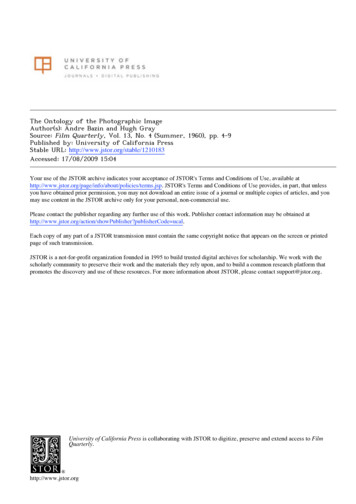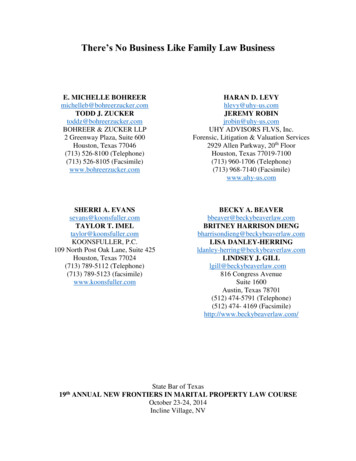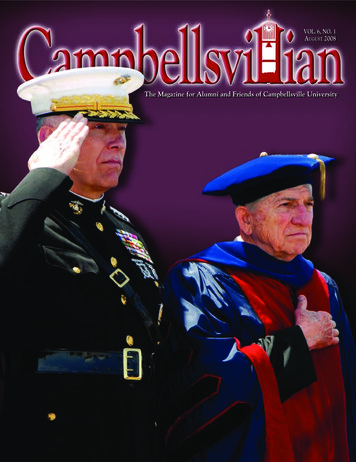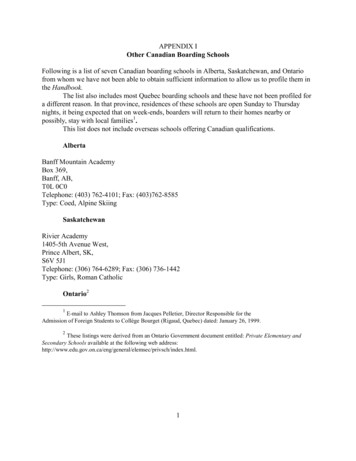
Transcription
!"# %&'()(* (, '"# -"('(*./0"12 34/*#56'"(.789: 5&;.# / 1& /&; 6*" ?./ @(6.2#: A1)4 B6/.'#.) C D()E FGC H(E I 7@644#.C FJKL9C 00E IMJ-6N)18"#; N : O&1P#.81' (, Q/)1,(.&1/ -.#88@'/N)# ORS: http://www.jstor.org/stable/1210183522#88#;: FTULVUWLLJ FX:LIYour use of the JSTOR archive indicates your acceptance of JSTOR's Terms and Conditions of Use, available rms.jsp. JSTOR's Terms and Conditions of Use provides, in part, that unlessyou have obtained prior permission, you may not download an entire issue of a journal or multiple copies of articles, and youmay use content in the JSTOR archive only for your personal, non-commercial use.Please contact the publisher regarding any further use of this work. Publisher contact information may be obtained herCode ucal.Each copy of any part of a JSTOR transmission must contain the same copyright notice that appears on the screen or printedpage of such transmission.JSTOR is a not-for-profit organization founded in 1995 to build trusted digital archives for scholarship. We work with thescholarly community to preserve their work and the materials they rely upon, and to build a common research platform thatpromotes the discovery and use of these resources. For more information about JSTOR, please contact support@jstor.org.University of California Press is collaborating with JSTOR to digitize, preserve and extend access to FilmQuarterly.http://www.jstor.org
4ANDREBAZINThe Ontology of the Photographic ImageTRANSLATED BY HUGH GRAYBefore his untimely death in 1958 Andre Bazin began to reviewand select for publication his post-World War II writingson the cinema. Of the planned four volumes, one was published in 1958,and a second in 1959; the remainder await some competent selectivehand. The first volume centers on the theme of the ontological basisof cinema or, as Bazin also puts it, "in lessterms:cinema as the art of reality." The secondthephilosophicalrelationsbetweenthe cinema and those arts with whichdiscusses theit has things in common-thetheater, the novel, and painting.A third volume was to have discussed the relations ofcinema and society; the fourth would have dealt with neorealism.What followsis a translation of the first chapter of volume one. To thosenot yet familiar with the writings of a man who might be describedwith justice as the Sainte-Beuve of film criticism,it should serve to reveal the informed clarity and perceptivenessof his mind, shining through the inevitable awkwardnesses andcompressions of writing under pressure as a jouranlist.It is difficult to estimate fully, as yet, the loss to the cinemaof a man who was counsellor as well as critic.If the plastic arts were put under psychoanalysis, the practice of embalming the deadmight turn out to be a fundamental factor intheir creation. The process might reveal thatat the origin of painting and sculpture therelies a mummy complex. The religion of ancientEgypt, aimed against death, saw survival asdepending on the continued existence of thecorporeal body. Thus, by providing a defenseagainst the passage of time it satisfied a basicpsychological need in man, for death is but thevictory of time. To preserve, artificially, hisbodily appearance is to snatch it from the flowof time, to stow it away neatly, so to speak, in
ANDREBAZINthe hold of life. It was natural, therefore, to keepup appearances in the face of the reality ofdeath by preserving flesh and bone. The firstEgyptian statue, then, was a mummy, tannedand petrified in sodium. But pyramids andOther forms of insurance were thereforesought. So, near the sarcophagus, alongsidethe corn that was to feed the dead, the Egyptians placed terra cotta statuettes, as substitutemummies which might replace the bodies ifthese were destroyed. It is this religous use,then, that lays bare the primordial function of
6the same kind of thing is the arrow-pierced claybear to be found in prehistoric caves, a magicidentity-substitute for the living animal, thatwill ensure a successful hunt. The evolution,side by side, of art and civilization has relievedthe plastic arts of their magic role. Louis XIVdid not have himself embalmed. He was content to survive in his portrait by Lebrun. Civilization cannot, however, entirely cast out thebogy of time. It can only sublimate our concern with it to the level of rational thinking.No one believes any longer in the ontologicalidentity of model and image, but all are agreedthat the image helps us to remember the subject and to preserve him from a second spiritualdeath. Today the making of images no longershares an anthropocentric, utilitarian purpose.It is no longer a question of survival after death,but of a larger concept, the creation of an idealworld in the likeness of the real, with its owntemporal destiny. "How vain a thing is painting" if underneath our fond admiration for itsworks we do not discern man's primitive needto have the last word in the argument withdeath by means of the form that endures. If thehistory of the plastic arts is less a matter of theiraesthetic than of their psychology then it willbe seen to be essentially the story of resemblance, or, if you will, of realism.Seen in this sociological perspective photography and cinema would provide a natural explanation for the great spiritual and technicalcrisis that overtook modern painting around themiddle of the last century. Andre Malraux hasdescribed the cinema as the furthermost evolution to date of plastic realism, the beginnings ofwhich were first manifest at the Renaissance andwhich found a limited expression in baroquepainting.It is true that painting, the world over, hasstruck a varied balance between the symbolicand realism. However, in the fifteenth centuryWestern painting began to turn from its ageold concern with spiritual realities expressed inthe form proper to it, towards an effort to combine this spiritual expression with as completean imitation as possible of the outside world.The decisive moment undoubtedly came withthe discovery of the first scientific and already,in a sense, mechanical system of reproduction,namely, perspective: the camera obscura of DaVinci foreshadowed the camera of Niepce. Theartist was now in a position to create theillusion of three-dimensional space within whichthings appeared to exist as our eyes in realitysee them.Thenceforth painting was torn between twoambitions: one, primarily aesthetic, namely theexpression of spiritual reality wherein thesymbol transcended its model; the other, purelypsychological, namely to duplicate the worldoutside. The satisfaction of this appetite forillusion merely served to increase it till, bit bybit, it consumed the plastic arts. However,since perspective had only solved the problemof form and not of movement, realism wasforced to continue the search for some way ofgiving dramatic expression to the moment, akind of psychic fourth dimension that couldsuggest life in the tortured immobility of baroque art.*The great artists, of course, have always beenable to combine the two tendencies. They havealloted to each its proper place in the hierarchyof things, holding reality at their commandand molding it at will into the fabric of theirart. Nevertheless, the fact remains that we arefaced with two essentially different phenomenaand these any objective critic must view separately if he is to understand the evolution of thepictorial. The need for illusion has not ceasedto trouble the heart of painting since the sixteenth century. It is a purely mental need, ofitself nonaesthetic, the origins of which must besought in the proclivity of the mind towardsmagic. However, it is a need the pull of whichhas been strong enough to have seriously upsetthe equilibrium of the plastic arts.* It would be interesting, from this point of view, to study in the illustratedmagazines of 1890-1910,the rivalry between photographic reporting and the use of drawings. The latter, in particular,satisfiedthe baroque need for the dramatic. A feeling for the photographicdocument developed only gradually.
7The quarrel over realism in art stems from amisunderstanding, from a confusion between theaesthetic and the psychological; between truerealism, the need that is to give significant expression to the world both concretely and in itsessence, and the pseudorealism of a deceptionaimed at fooling the eye (or for that matter themind); a pseudorealism content in other wordswith illusory appearances.* That is why medieval art never passed through this crisis; simultaneously vividly realistic and highly spiritual, it knew nothing of the drama that came tolight as a consequence of technical developments. Perspective was the original sin of Western painting.It was redeemed from sin by Niepce andLumiere. In achieving the aims of baroque art,photography has freed the plastic arts from theirobsession with likeness. Painting was forced, asit turned out, to offer us illusion and this illusionwas reckoned sufficient unto art. Photographyand the cinema on the other hand are discoveries that satisfy, once and for all and in its veryessence, our obsession with realism.No matter how skillful the painter, his workwas always in fee to an inescapable subjectivity.The fact that a human hand intervened cast ashadow of doubt over the image. Again, theessential factor in the transition from the baroque to photography is not the perfecting of aphysical process (photography will long remainthe inferior of painting in the reproduction ofcolor); rather does it lie in a psychological fact,to wit, in completely satisfying our appetite forillusion by a mechanical reproduction in themaking of which man plays no part. The solution is not to be found in the result achieved butin the way of achieving it.tfThis is why the conflict between style andlikeness is a relatively modern phenomenon of*which there is no trace before the invention ofthe sensitized plate. Clearly the fascinating objectivity of Chardin is in no sense that of thephotographer. The nineteenth century saw thereal beginnings of the crisis of realism of whichPicasso is now the mythical central figure andwhich put to the test at one and the same timethe conditions determining the formal existenceof the plastic arts and their sociological roots.Freed from the "resemblance complex," themodern painter abandons it to the masses who,henceforth, identify resemblance on the onehand with photography and on the other withthe kind of painting which is related to photography.Originality in photography as distinct fromoriginality in painting lies in the essentially objective character of photography. [Bazin heremakes a point of the fact that the lens, the basisof photography, is in French called the "objectif," a nuance that is lost in English.-TR.] Forthe first time, between the originating objectand its reproduction there intervenes only theinstrumentality of a nonliving agent. For thefirst time an image of the world is formed automatically, without the creative intervention ofman. The personality of the photographerenters into the proceedings only in his selectionof the object to be photographed and by way ofthe purpose he has in mind. Although the finalresult may reflect something of his personality,this does not play the same role as is played bythat of the painter. All the arts are based onthe presence of man, only photography derivesan advantage from his absence. Photographyaffects us like a phenomenon in nature, like aflower or a snowflake whose vegetable or earthlyorigins are an inseparable part of their beauty.This production by automatic means has radically affected our psychology of the image. Theobjeetive nature of photography confers on it aPerhaps the Communists, before they attach too much importance to expressionist realism, should stoptalking about it in a way more suitable to the eighteenth century, before there were such things asphotography or cinema. Maybe it does not really matter if Russian painting is second-rate provided shegives us first-rate cinema. Eisenstein is her Tintoretto.f There is room, nevertheless, for a study of the psychology of the lesser plastic arts, the molding of deathmasks, for example, which likewise involves a certain automatic process. One might consider photography, in this sense as a molding, the taking of an impression, by the manipulation of light.
8quality of credibility absent from all other picture-making. In spite of any objections ourcritical spirit may offer, we are forced to acceptas real the existence of the object reproduced,actually re-presented, set before us, that is tosay, in time and space. Photography enjoys acertain advantage in virtue of this transferenceof reality from the thing to its reproduction.*A very faithful drawing may actually tell usmore about the model but despite the promptings of our critical intelligence it will never havethe irrational power of the photograph to bearaway our faith.Besides, painting is, after all, an inferior wayof making likenesses, an ersatz of the processesof reproduction. Only a photographic lens cangive us the kind of image of the object that iscapable of satisfying the deep need man has tosubstitute for it something more than a mereapproximation, a kind of decal or transfer. Thephotographic image is the object itself, theobject freed from the conditions of time andspace that govern it. No matter how fuzzy,distorted, or discolored, no matter how lacking,in documentary value the image may be, itshares, by virtue of the very process of its becoming, the being of the model of which it isthe reproduction; it is the model.Hence the charm of family albums. Thosegrey or sepia shadows, phantomlike and almostundecipherable, are no longer traditional familyportraits but rather the disturbing presence oflives halted at a set moment in their duration,freed from their destiny; not, however, by theprestige of art but by the power of an impassivemechanical process: for photography does notcreate eternity, as art does, it embalms time,rescuing it simply from its proper corruption.Viewed in this perspective, the cinema is objectivity in time. The film is no longer contentto preserve the object, enshrouded as it were inan instant, as the bodies of insects are preservedintact, out of the distant past, in amber. Thefilm delivers baroque art from its convulsivecatalepsy. Now, for the first time, the image ofthings is likewise the image of their duration,change mummified as it were. Those categoriesof resemblance which determine the speciesphotographic image likewise, then, determinethe character of its aesthetic as distinct fromthat of painting.tThe aesthetic qualities of photography are tobe sought in its power to lay bare the realities.It is not for me to separate off, in the complexfabric of the objective world, here a reflexionon a damp sidewalk, there the gesture of achild. Only the impassive lens, stripping itsobject of all those ways of seeing it, those piledup preconceptions, that spiritual dust and grimewith which my eyes have covered it, are able topresent it in all its virginal purity to my attention and consequently to my love. By the powerof photography, the natural image of a worldthat we neither know nor can know, nature atlast does more than imitate art: she imitates theartist.Photography can even surpass art in creativepower. The aesthetic world of the painter is ofa different kind from that of the world abouthim. Its boundaries enclose a substantially andessentially different microcosm. The photographas such and the object in itself share a commonbeing, after the fashion of a fingerprint. Wherefore, photography actually contributes something to the order of natural creation insteadof providing a substitute for it. The surrealistshad an inkling of this when they looked to thephotographic plate to provide them with theirmonstrosities and for this reason. The surrealistdoes not consider his aesthetic purpose and the* Here one shouldreally examine the psychology of relics and souvenirs which likewise enjoy the advantages of a transferof reality stemming from the "mummy-complex."Let us merely note in passing thatthe Holy Shroud of Turin combines the features alike of relic and photograph.f I use the term category here in the sense attached to it by M. Gouhier in his book on the theater inwhich he distinguishes between the dramatic and the aesthetic categories. Just as dramatic tension has noartistic value, the perfection of a reproduction is not to be identified with beauty. It constitutes rather theprime matter, so to speak, on which the artistic fact is recorded.
9mechanical effect of the image on our imaginations as things apart. For him, the logical distinction between what is imaginary and what isreal tends to disappear. Every image is to beseen as an object and every object as an image.Hence photography ranks high in the order ofsurrealist creativity because it produces animage that is a reality of nature, namely, anhallucination that is also a fact. The fact thatsurrealist painting combines tricks of visual deception with meticulous attention to detail substantiates this.So, photography is clearly the most important event in the history of the plastic arts.Simultaneously a liberation and an accomplishment, it has freed Western painting, once andfor all, from its obsession with realism andallowed it to recover its aesthetic autonomy.Impressionist realism, offering science as analibi, is at the opposite extreme from eye-deceiving trickery. Only when form ceases tohave any imitative value can it be swallowed upin color. So, when form, in the person of C6zanne, once more regains possession of thecanvas there is no longer any question of theillusions of the geometry of perspective. Thepainting, being confronted in the mechanicallyproduced image with a competitor able to reachout beyond baroque resemblance to the veryidentity of the model, was compelled into thecategory of object. Henceforth Pascal's condemnation of painting is itself rendered vainsince the photograph allows us on the one handto admire in reproduction something that oureyes alone could not have taught us to love, andon the other, to admire the painting as a thingin itself whose relation to something in naturehas ceased to be the justification for its existence.On the other hand, of course, cinema is alsoa language.1.New PeriodicalsDefinition:QuarterlyJournalof Film Criticism.33 Electric Avenue, London S.W.9, England.2s. 6d. A new journal edited by former studentsand staff members of the London School ofFilm Technique, aiming at a more responsible"new criticism" of films. The editors note thatsince Lindsay Anderson's famous article, "StandUp! Stand Up!" in Sight & Sound three yearsago, "the cry has been repeated, the thesis elaborated and the case restated with increasingshowmanship; so that those who began as isolated prophets can now find reward in the satisfactions of preaching to the converted. Butcriticism has not noticeably changed."The first issue contains "Towards a Theory,"by Dai Vaughan, who points out that "any criticism assumes an aesthetic, even though thisaesthetic may not be made conscious or explicit," and suggests certain basic lines for a committed aesthetic theory. Stuart Hall comparesLook Back in Anger and Room at the Top inwhat is probably the best piece yet done onthese films. Mr. Vaughan also contributes "Complacent Rebel" on Robert Flaherty, and theissue includes as well an interview with Franqois Truffaut by Fernando Lopes, pieces on filmschools by David Naden and Boleslaw Sulik, acurious pair of notes for and on films by JohnIrvin, and "Two Lost Generations?" by ArnoldWesker. We hope that Definition survives theeconomic perils of a new independent magazine.For Film is the publication of the rejuvenatedAmerican Federation of Film Societies, Box2607, Grand Central Station, New York 17, N.Y.Founded in 1955, the AFFS is a nonprofit organization with the basic aim of assisting existing film societies and encouraging the formationof new ones. The first issue of For Film, whichis the successor to the AFFS Newsletter, contains an editorial by Gideon Bachmann, newAFFS President, notes on films newly availablefor film societies, several book reviews, an interview with Rod Steiger, and news notes of various kinds. To be published approximately fourtimes a year; 1.00 a year.
light as a consequence of technical develop- ments. Perspective was the original sin of West- ern painting. It was redeemed from sin by Niepce and Lumiere. In achieving the aims of baroque art, photography has freed the plastic arts fr










